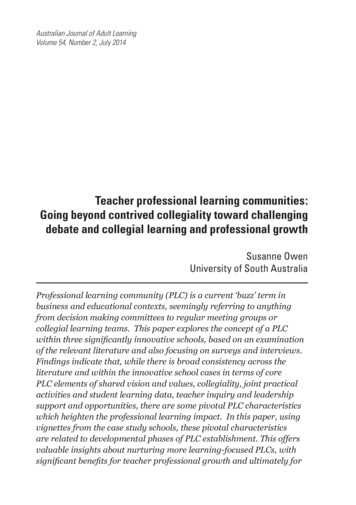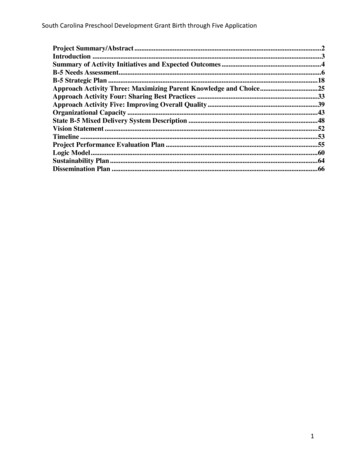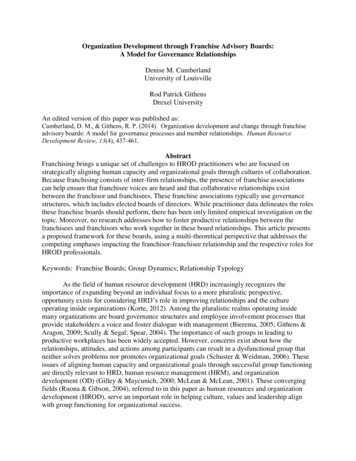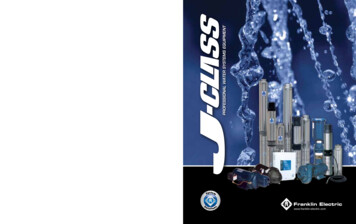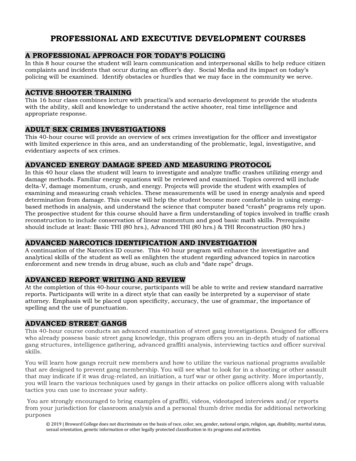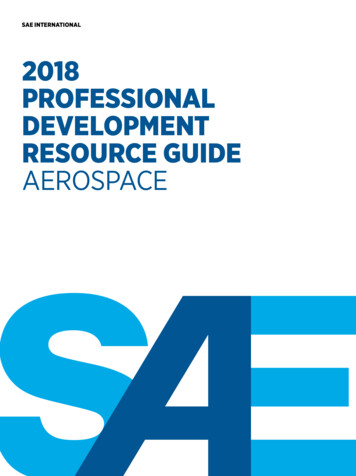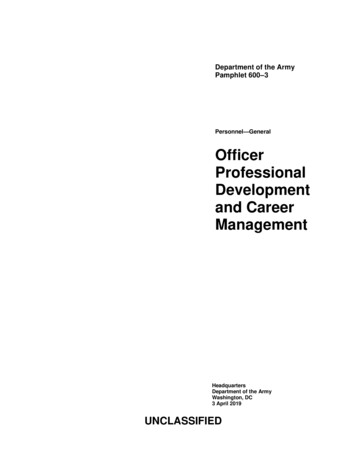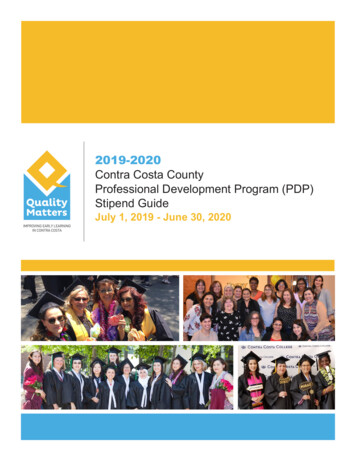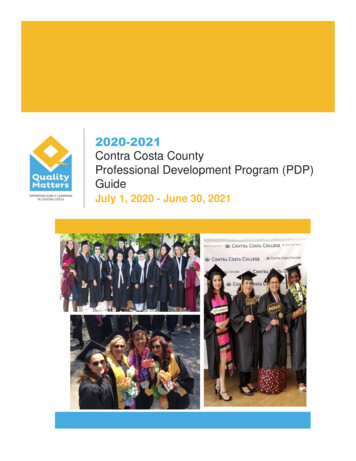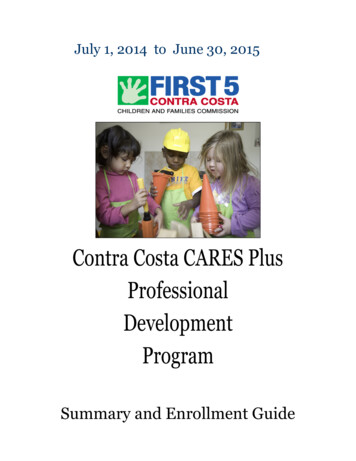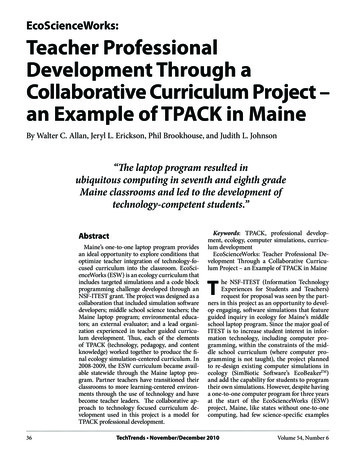
Transcription
EcoScienceWorks:Teacher ProfessionalDevelopment Through aCollaborative Curriculum Project –an Example of TPACK in MaineBy Walter C. Allan, Jeryl L. Erickson, Phil Brookhouse, and Judith L. Johnson“The laptop program resulted inubiquitous computing in seventh and eighth gradeMaine classrooms and led to the development oftechnology-competent students.”AbstractMaine’s one-to-one laptop program providesan ideal opportunity to explore conditions thatoptimize teacher integration of technology-focused curriculum into the classroom. EcoScienceWorks (ESW) is an ecology curriculum thatincludes targeted simulations and a code blockprogramming challenge developed through anNSF-ITEST grant. The project was designed as acollaboration that included simulation softwaredevelopers; middle school science teachers; theMaine laptop program; environmental educators; an external evaluator; and a lead organization experienced in teacher guided curriculum development. Thus, each of the elementsof TPACK (technology, pedagogy, and contentknowledge) worked together to produce the final ecology simulation-centered curriculum. In2008-2009, the ESW curriculum became available statewide through the Maine laptop program. Partner teachers have transitioned theirclassrooms to more learning-centered environments through the use of technology and havebecome teacher leaders. The collaborative approach to technology focused curriculum development used in this project is a model forTPACK professional development.36Keywords: TPACK, professional development, ecology, computer simulations, curriculum developmentEcoScienceWorks: Teacher Professional Development Through a Collaborative Curriculum Project – an Example of TPACK in MaineThe NSF-ITEST (Information TechnologyExperiences for Students and Teachers)request for proposal was seen by the partners in this project as an opportunity to develop engaging, software simulations that featureguided inquiry in ecology for Maine’s middleschool laptop program. Since the major goal ofITEST is to increase student interest in information technology, including computer programming, within the constraints of the middle school curriculum (where computer programming is not taught), the project plannedto re-design existing computer simulations inecology (SimBiotic Software’s EcoBeakerTM)and add the capability for students to programtheir own simulations. However, despite havinga one-to-one computer program for three yearsat the start of the EcoScienceWorks (ESW)project, Maine, like states without one-to-onecomputing, had few science-specific examplesTechTrends November/December 2010Volume 54, Number 6
of educational technologies. In addition, scienceteachers in Maine middle schools relied on activity-based and content-focused curriculum toteach ecology in their classrooms. Thus, it wasrecognized that not only would the project needto develop middle school appropriate computersimulations but also would have to integratethis technology into the classroom. The methodof accomplishing this was to enlist teachers aspedagogical experts to write a curriculum thatfocused on this technology to teach ecology, thusplacing teachers at the center of the integrationof technology into their content and pedagogicalknowledge.Ubiquitous ComputingLeads tochallengesTeachers: challenged tointegrate computers intotheir curriculum may havenegative perceptions ofstudents and computersStudents: rapidlybecome technologycompetent with highexpectations of newlearning environmentThe Maine Laptop ProgramIntroduced to seventh grade across the stateof Maine in 2002, the Maine Learning Technology Initiative (MLTI) made it very clear that theinitiative was about more than just the technology (Holcomb 2009). By 2003 every seventh andeighth grade teacher and student had a laptop.From the onset of the program, professionaldevelopment focused on content areas, helpingteachers understand how their classrooms couldbe more effective by integrating technology intogood classroom practice. School administratorswere also included in the workshops to promote technology integration into school goals,visions, and policies. By 2005 middle schoolteachers across the state were at various levels oftechnology knowledge and integration into theirclassrooms.The laptop program resulted in ubiquitouscomputing in seventh and eighth grade Maineclassrooms and led to the development of technology-competent students. Ideally, this allowsteachers to transition into the role of facilitators,guiding their students to be autonomous learners. However, Figure 1 shows the challenges inthis process for both teachers and students.The EcoScienceWorks ProjectOvercoming these challenges became an important part of the ESW project. The initial focusof the project was to provide the engaging andchallenging inquiry software noted on the lowerright of Figure 1 (the role of SimBiotic Softwarewith teacher input). The project organizers alsorecognized the need to provide teacher professional development (lower left side of figure) andplanned to do so in an indirect manner by enlisting the teachers as pedagogical partners.The ESW project became a collaboration withmany partners each of whom supplied portionsof the technology, pedagogy and content knowledge (TPACK) needed. This collaboration wasVolume 54, Number 6Need to meet these ing &challenginginquirysoftwareLearning centered classroom ofautonomous learnersFigure 1. Challenges and goals in the one-to-one computer classroomdesigned to provide teacher professional development as an outgrowth of teachers becominginvolved in the project’s tasks – specifically towrite a curriculum that integrated the computer simulations into their teaching. Whileantedating the recent interest in TPACK, theESW project, like other projects mentionedby Mishra et al (2009), models an approach tosuccessfully integrating new technology in theclassroom. The project partners and their rolesare shown in Table 1 on the next page.Using backward design, the teachers weretasked to develop the ESW curriculum toguide the use of the computer simulations andinclude an allied field experience that wouldgive students a hands-on activity in ecology.Maine middle school science teachers were recruited from throughout the state and asked towrite lesson plans with the help of the MaineTechTrends November/December 201037
GROUPROLESimBiotic Software &MIT Teacher Education Programsoftware developmentTechnology & Pedagogywrite lesson plans toalign with software,design field experiences23 Maine middle schoolscience teachersPedagogy & Contentguide software andcurriculum designMaine Learning TechnologyInitiative(Laptop program)Technology & Pedagogyleadership, teambuilding, communicationKieve facilitatorsenvironmental educatorsguide software,lesson plans, and fieldexperience designMaine AudubonContent & PedagogyJohnSilver Associatesexternal evaluatorFBR’s ScienceWorks for MElead organizationTable 1. EcoScienceWorks PartnersAudubon environmental educators. Given thegeographic size of Maine, a setting for the project’s workshops needed to include overnight facilities. The project took on the work of developing the integrated EcoScienceWorks curriculumand software during two, weeklong summercurriculum institutes at Camp Kieve. Over thethree years of the project, teacher professionaldevelopment around a TPACK model was observed. The result of the ESW project was a curriculum that supports 5 targeted simulationsin ecology based on Maine ecosystems and aprogramming module called Program a Bunny.The concepts and names of the simulations areshown in Table 2. More information about thecurriculum can be found at SimBiotic Software’sproject site: http://simbio.com/Maine.Evaluation MethodsUsing the most recent guidelines set forth bythe Joint Committee on Standards for EducationEvaluation (1994), the evaluation plan was designed to be ongoing and provide assessment anddocumentation of the effectiveness and efficacyof the project activities to both the project staffand the granting agency. The evaluation consisted of observation as well as survey methodology.Specifically, the evaluator spent time at Camp Kieve observing process and recording impressionsduring the summer workshops and conductedtelephone interviews and online surveys during the school year to collect data from teachersabout their experience, successes, and concerns.Yearly formal reports to the project’s principal investigator form the basis of the results.EBME LABCONTENTResultsBeaver Pond SuccessionSuccessionEdgelands & Fractured ForestsHabitat fragmentationKeystone PredatorSpecies interactionsTwenty-three Maine middle school scienceteachers who taught ecology were recruited forthe project. Teachers committed 3 years to theproject and their response to surveys and interviews are reported. The results are organized tohighlight the TPACK features of the project.Lake InvadersInvasive speciesRunaway RunoffNon-point sourcepollutionCode Block ProgrammingProgram a BunnyTable 2 - EcoBeaker Maine Explorer (EBME) Labs38Evaluating EcoScienceWorks ITEST project asTPACK Professional DevelopmentA TPACK professional development opportunity for middle school science teachers will ideally address a perceived need of the teacher andaccomplish the following: Technology Expose teachers to new/relevant knowledgein technology as it relates to the content area(computer programming/modeling as an approach to deepen understanding in scienceand promoting skilled scientific thinking)TechTrends November/December 2010Volume 54, Number 6
Increase/deepen teacher comfort, knowledge,and understanding of how technology can improve teaching and learning in the content area Pedagogy Model the learning-centered environment thatguides student inquiry, supports collaboration, and incorporates technology Content Increase/deepen teacher knowledge and understanding in the content areaDid ESW expose teachers to new/relevantknowledge in technology as it relates to the content area?EcoBeaker Maine Explorer (EBME) is the focus of the ESW curriculum. At the beginning ofthe project, 47% of the teachers responded thatthey had little skill with simulation software andhad never used it on their own or with their students. By the end of the ESW project, all statedthat they included simulation software in theirteaching and learning and integrated it effectively into their lessons.Comments from teacher interviews demonstrated that they were enthusiastic about usingthe EBME computer simulations to teach ecology content to their students and included:“I think that having available simulation programs that we can integrate into our curriculum has shown me the effectiveness of usingthese as part of hands-on learning. Seeing theactual increase in retention of material by thestudents has convinced me that these programswill become more and more part of the humanlearning process. My skill at integrating thisinto the classroom has overhauled how I utilizethe laptops.”“As a result of the EBME program, I am offering more science instruction. It is an interactiveunit which allows students to use and have fun atthe same time. This program provides a new toolfor students to use in their learning.”Programming is not listed as a Maine learning standard and requires teachers to see itsvalue as an aid to teaching computationalthinking, problem solving, and the underpinnings of simulations. The programming module allows teachers and students to explorecomputer programming via the code block interface and includes progressively more complex programming challenges. Prior to participating in the project, 76% of the teachersreported that using a programming languagewas very new to them and 88% noted that theyhad never used a computer language on theirown or with their students. In the school yearVolume 54, Number 6following the completion of the ESW project, 94% of the project teachers taught theprogramming module in their classroomsin addition to teaching at least one EBMElab. Teachers’ comments regarding the valuethat the programming module, Program aBunny (PaB), brings to their students included the following:“Students were engaged and found it easy towork cooperatively. PaB also gave me a chanceto demonstrate the scientific method, PredictExperiment-Observe, watch students workand let students lead the critical thinking.”“It helps them to understand programminglanguage and how the rules of the programgovern the simulation.”“The result of theESW project was acurriculum thatsupports 5 targetedsimulations in ecologybased on Maineecosystems and aprogramming modulecalled Program a Bunny.Eighty-eight percent ofteachers who taught theProgram a Bunny unitin the classroom also encouraged their students toexplore the unit on theirown. Teachers’ commentsregarding the value theysee in encouraging thisinclude:“I see a lot of value inguided exploration. Students first express delightin the freedom of exploration then confusion abouthow to proceed. Whenstudents explore, they confront their own misconceptions and build their own understandings.”“I place great value in controlled flounderingand exploration. That’s when I get to observesome great thinking.”Did ESW increase/deepen teacher comfort,knowledge, and understanding of how technology can improve teaching and learning inthe content area?EBME labs use spreadsheets to facilitatestudent skills in data entry and visualizationby graphing. At the beginning of the ESWproject, the majority of teachers (88%) responded that they understood the relevance ofspreadsheet use and were at least beginning touse spreadsheet programs with their students.Most teachers were using spreadsheets for dataentry and graphing with fewer having studentsuse spreadsheets for calculation. By the end ofthe project all teachers were using spreadsheetprograms for data entry and graphing, andTechTrends November/December 201039
53% of teachers were using spreadsheet programs in the classroom for calculation. At theconclusion of the ESW project, approximatelyone-third of the teachers indicated that theyextended the use of spreadsheets in their teaching and learning beyond the ESW project andfelt they were using them in powerful ways.Did ESW model the learning-centered environment that guides student inquiry, supportscollaboration, and incorporates technology?As the project progressed it became apparent that teachers were adopting roles asfull partners in the veloped novel ways toincrease student understanding of computersimulations and computerprogrammingtherebydemonstrating their comfort in innovating portions of the curriculumthemselves. One team developed a game about habitat as it relates to predator/prey dynamics andanother team developedactivities called “Interactive Simulations” to helpstudents understand therule-based nature of programming. These activities were models for whattakes place in the EBMEsimulation labs and PaB.Further evidence thatthe ESW project modeled the learning-centered classroom for teachers is seen in the following comments from the evaluator’s reports:“The ‘best part to the week’ for the majority of teachers was working with other teachers, sharing practices, resources, and strategies,and interacting with colleagues to get otherperspectives on teaching. Over a period of fivedays and nights, a collegial network developedand all were engaged and enthusiastic about regrouping for the piloting of the first draft of thecurriculum during week 2.”As the projectevolved it becameapparent thatteacher changewas occurringserendipitouslythrough thecollaborativecurriculumdevelopmentproject with theemergence ofteacher leaders.When teachers were asked “What was thebest part of the week for you?” comments included:“Being in a positive learning community.”“Collaborating with other teachers.”“Working with and hearing about what otherteachers have done, both with this project andwith other classroom activities.”40The evaluator noted:“Teachers gained new tools with which toteach units about ecology and technology intheir classrooms. They also experienced thecollegiality that goes along with being togetherwith other teachers on a daily basis, sharingteaching techniques, new knowledge, classroomexperiences, meals, housing, and recreationalactivities.”Finally, teachers have become leaders as aconsequence of their experiences in the project. All but one of the teachers stated that theyhad presented the ESW curriculum at a conference or workshop and 50% made 2 or morepresentations. Teachers who attended a workshop led by ESW project teachers completedsurveys following the workshop. Ninety-threepercent of attendees indicated that havingteachers who developed the ESW project present the curriculum was helpful and 95% saidthey plan to implement the ESW curriculumin the near future.Did ESW increase/deepen teacher knowledgeand understanding of ecology content?Each unit features a Maine ecosystem andfocuses on ecological concepts including succession, habitat fragmentation, predator/preyrelationships, invasive species, and runoff. Aretrospective pre/post survey revealed significant changes in teachers’ feelings of preparedness to teach these ecological concepts followingtheir involvement with the project. The conceptsassessed were succession; food/energy chainsand webs; predator/prey relationships; habitatfragmentation; invasive species; and non-pointsource pollution and runoff. With the exception of predator/prey relationships in whichteachers felt they were equally prepared to teachthe concept prior to the project as following it,all other concepts showed significant change(paired t-test, p 0.01). The most significant improvements were noted in teachers’ feelings ofpreparedness to teach about succession, habitatfragmentation, invasive species, and non-pointsource pollution - the major concepts in four ofthe EBME labs.Did ESW meet the challenges teachers confrontas a result of ubiquitous computing?Evidence that the project also impacted teacherreservations about using computer simulationsto teach ecology is suggested by teacher comments about their intention to continue usingthe curriculum when asked, “Will you continueto teach ecology using the ESW curriculum after the grant period?”. Comments included:TechTrends November/December 2010Volume 54, Number 6
“ABSOLUTELY! I love the simulation. Students are just getting used to their computers, sothey are engaged. It is also a great way to teachstudents how to collect accurate data, and publish and analyze data.”“Yes! My students have enjoyed the ESW curriculum very much and have learned a greatdeal without realizing how hard they have beenworking.”As mentioned above, in the school year following the completion of the ESW project, 94%of the project teachers taught both an EBME laband the PaB unit in their classrooms. In addition, the project has produced software that delivers on the promise of the laptop program forstudents. Teachers provided feedback commentsthat attest to this:“It has been so rewarding to see kids engagedand successful. Even those kids who are alwayssaying, ‘I don’t get it. I don’t get it.’ are gettingthis and loving it.”“ I find it inspiring that the EBME programhas such a high perseverance across the spectrum. The language is difficult for kids at thesecond or third grade reading level and if thishad been a paper activity, they would have givenup. They did not, and that is AWESOME!”DiscussionThe EcoScienceWorks curriculum was developed as a way for students to use technology toexperience science in realistic ways. Ecology is ascience content area that is frequently taught inthe seventh and/or eighth grade when all Mainestudents have a laptop. The ESW project teachers were a self-selected group with an interest inecology. Some of them, however, were tentativeabout using computers to teach ecology, believing ac
23 Maine middle school science teachers write lesson plans to align with software, design field experiences Pedagogy & Content Maine Learning Technology Initiative (Laptop program) guide software and curriculum design Technology & Pedagogy Kieve facilitators leadership, team building, comm
